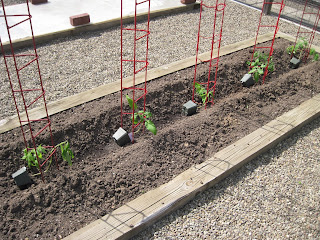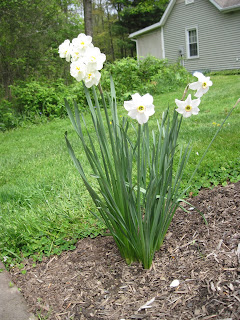Around here, Memorial Day weekend is THE big gardening weekend. Some people get their garden tilled up, head to the greenhouse, and stock up on plants. They spend all day planting and seeding and staking. This year on Saturday evening we had an inch and a quarter of rain fall in about half an hour. I know of at least one garden that got washed away. Not mine. Of course by this time I've been gardening for months, but Memorial Day is the deadline. So I also had a busy weekend. While I've been at this for months, I still had four beds that hadn't been touched. I cultivated and amended them and I planted buckwheat in a couple that are not going to be used until later.
Bed #1: Vacant - planted buckwheat - cucumbers later
Bed #2: Lettuce planted and cucumbers just now germinating
Bed #3: Peas planted - bush beans later
Bed #4: Peas planted - bush beans later
Bed #5: Sweet corn seeded and pumpkins next weekend
Bed #6: Soil warming for sweet corn
Bed #7: Cantaloupes seeded
Bed #8: Tomatoes and eggplants - mulched and finished
Bed #9: Peas planted - buckwheat later - lettuce added
Bed #10: Peas planted - buckwheat later - lettuce added
Bed #11:Buckwheat and a zucchini seeded
Bed #12:Vacant - buckwheat later - this is my nursery bed
Bed #13: Cauliflower and Broccoli
Bed #14: Potatoes growing fast
Containers: Carrots getting their first true leaves
Still waiting on my cauliflower and broccoli to do something. But it's a pretty bed. The plants are big and healthy. The soil looks perfect. Its nice to walk by ten times a day.
The potato plants visibly grow taller each sunny day.
The tomato and eggplant bed is finished, mulched, and I planted basil in between the tomato plants. There are also Nasturtium seeds in there.
I planted rows of lettuce along the east side of two pea beds. I still have enough transplants for two more rows but I am holding them back. I will begin trimming lettuce for salads today.
This is the lettuce I stuck into the ground and ignored. I only lost one seedling.
There are cucumbers seeded along the left side.
So far just one tiny cucumber plant.
This is the last bed to be cultivated. It is nearest the gate and the water so it usually ends up as my nursery bed. It will get buckwheat later. I have my late lettuce babies, some spare Marigolds and all of the Sunpatiens and Begonias that go in the front landscaping. There are also volunteer Calendula growing well at the far end. When I get a minute I am going to transplant some of the Calendula into four inch pots. I took a minute and transplanted the Marigolds from cell packs into four inch pots. It is IMPOSSIBLE to keep cell packs watered out in the open sun/wind. Some of them have an intended home, but this will buy me some time and any leftovers will go into gallon pots.
We are still in construction mode.
We have been stockpiling city street bricks for walkways.
We had a large Hemlock tree on the property line with our next door neighbors. Have you ever had a tree that was just in the wrong place? Especially a dirty tree that drops a lot of cones or nuts or needles? This one had worn out its welcome. We have a walkway that goes past there and it is always full of Hemlock crap, and in the winter, the roots heaved the edging and it was basically a mess. The tree also did a lot to shade the portion of the lawn that we call "Lake Johnson". Tim said he could hear the lawn drying out as soon as that tree was gone. After it was gone, the neighbor wife came over to survey he hole and asked what we were going to plant there to replace it. Well, that's fair. I suppose they can have a large bush or a small tree. We had at least figured on an arrangement of tall grasses and some more rocks. Once Tim gets the roots pulled out and the hole filled, we'll go shopping for a shrub.
It seems like there is always an empty hole around here that needs to be planted...


















































